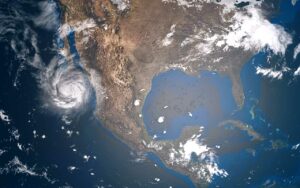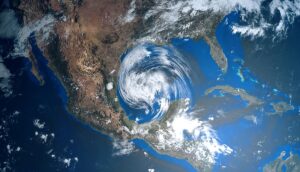On Tuesday, satellite photos showed a Chilean Lake that provides water for 2 million people has completely dried out. Lakes around the U.S. have recently reached their lowest levels in history, prompting water rationing.
Lake providing water for 2 million people in Chile dries out, wildlife left without water
New satellite observations, published on Tuesday, revealed before and after images of the Peñuelas Lake shows that the body of water which provides drinking water for 2 million people appears to have dried out.
In contrasting photos from April 2016 and this month, the branch-shaped Lake, located around 70 miles west of Santiago’s capital, showed an expanse of dark blue water six years ago. But now, it is a yellow-ish scar in the landscape and appears completely dried out, the Independent reported.
Peñuelas Lake, along with Los AromosLake, was one of the primary water supply sources for the Valparaíso region. As a result of the loss of water sources, many rural communities are now forced to have drinking water delivered by trucks from other areas.
However, local animal and plant life are without such external resources. Tens of thousands of farm animals have died, Yahoo reported.
Chile’s government declared agriculture emergencies in over fifty areas in August 2019, after facing a mega-drought since 2010.
Rainfall in central Chile has been up to 45% below the average for the past decade, while rain in Santiago has been at 80-90% below normal levels.
It is the worst drought in modern history for the nation, and scientists attribute at least 25% of the severity to climate change. The remaining 75%, scientists say, result from natural cycles in atmospheric circulation, rainfall patterns, and ocean temperatures.
America’s drought crisis is worsening as climate change threatens U.S. food, water, and electricity supply
As climate change produces impacts worldwide, and as parts of the United States are also suffering from severe drought, scientists and environmentalists are raising the alarm.
The Guardian reported that California’s agricultural belt provides 25% of America’s food, and many areas will have no water this year.
In late February, Federal authorities announced that they would be reducing their water deliveries to cities and farms, that there would be further shortages this summer, and that some farms would receive no water this summer, the Mercury News reported.
The Central Valley water project is California’s most extensive water delivery system, and is the lifeblood of many of the state’s major agricultural areas.
This represents the third year of severe drought for the Golden State, where the snowfall is far below historical averages, KTLA reported. Reservoirs have decreased by 26.5%
According to the U.S. Bureau of Reclamation, Lake Mead, a key reservoir on the Colorado River that runs along the Nevada-Arizona border, reached its lowest level since it was first filled in the 1930s.
The Colorado River aqueduct provides water to about 19 million people in Southern California, Las Vegas, Nevada, and Phoenix and Tucson, Arizona. However, the latter two may soon not be receiving as much water, forcing those communities to find water elsewhere or force rationing, KTLA reported. In addition, Mexico would also receive less water from the Colorado River.
Lake Powell, which rests in Utah and Arizona, also gets its water from the Colorado River and drops to its lowest level in history since first being filled over half a century ago, in March 2022, the Gazette reported. The Lake is also key in producing hydropower at the Glen Canyon dam. And a lower water level could impact electricity generation in seven states.









